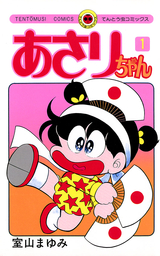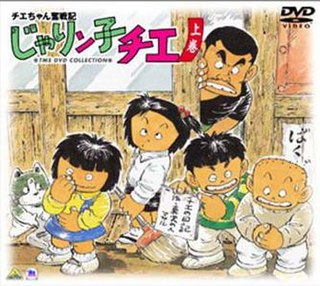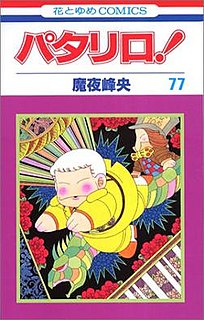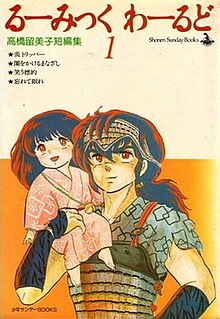 W
WAsari-chan (あさりちゃん) is a Japanese shōjo slice of life manga series by Mayumi Muroyama. It was adapted into an anime television series and an anime film. The TV series was produced by Toei Animation a subsidiary of Toei Company, and directed by Kazumi Fukushima. The anime follows Asari, a normal but stupid elementary school fourth-grade girl who does not get along with her family.
 W
WCalifornia Story is a Japanese manga series written and illustrated by Akimi Yoshida, serialized in Bessatsu Shōjo Comic from 1978 to 1981.
 W
WClaudine is a Japanese shōjo manga series written and illustrated by Riyoko Ikeda. It was serialized in two issues of Shueisha's Weekly Margaret magazine in January 1978 and later published in a single tankōbon volume under the Margaret Comics imprint on May 20, 1978. Seven Seas Entertainment licensed the series for an English-language release in North America, published on June 26, 2018. Claudine is notable for being one of the earliest manga to feature a transgender protagonist.
 W
WCobra is a Japanese manga series written and illustrated by Buichi Terasawa. Set in the far future, the series tells the story of Cobra, who lives an adventurous life until his enemies begin to hunt him down. Cobra surgically alters his face and erases his own memory to hide from his foes and have a normal life. Eventually, he regains his memories and reunites with his former partner Lady Armaroid. Terasawa devised it as a mix of spaghetti western and samurai stories, and aspects of films, varying from James Bond to Disney.
 W
WGame Center Arashi is a Japanese manga by Mitsuru Sugaya, which ran in CoroCoro Comic from 1978 to 1984. It focus on Arashi Ishino, a young gamer whose life revolves around video games. The manga, which is one of the earliest Japanese video game-themed comics, sold over 5 million copies and won the 1983 Shogakukan Manga Award for children's manga. The series was adapted as a popular anime television show that aired in 1982 in Japan on Mondays from 7:00pm to 7:30pm.; and in Hong Kong.
 W
WGanbare!! Tabuchi-kun!! , is a yonkoma manga series by Hisaichi Ishii which ran in the weekly Manga Action magazine from 1978 to 1979 in Japan. After that series ended, Ishii continued creating more baseball gag comics which were then collected under the title Tabuchi-kun (タブチくん) and released from 1985 to 1989.
 W
WJarinko Chie is a Japanese manga series written and illustrated by Etsumi Haruki. It was serialized by Futabasha in Manga Action between 1978 and 1997 and collected in 67 bound volumes, making it the 45th longest manga released. Jarinko Chie received the 1981 Shogakukan Manga Award for general manga.
 W
WMajokko Tickle , also known as Magical Girl Tickle or Magical Girl Chickle, is a 1970s magical girl manga and anime by Go Nagai. Unlike Nagai's earlier Cutie Honey, Majokko Tickle is closer to the more traditional mold of magical girl anime such as Mahoutsukai Sally, and unlike Nagai's other, more popular works, was created for an audience of pre-teen girls.
 W
WNine is a baseball manga series by Mitsuru Adachi. It was serialized in Monthly Shōnen Sunday Zōkan from the October 1978 through November 1980 issues. The series was adapted into three anime television films and a live-action television drama. An altered version of the first anime film was released in theaters, with new and re-arranged music.
 W
WPatalliro! is a Japanese manga series written and illustrated by Mineo Maya. The comedy manga was serialized in Hana to Yume from 1978 to 1990, before switching to Bessatsu Hana to Yume in 1991 where it continues. The 1980s Boku Patalliro! (ぼくパタリロ!) anime adaptation by Toei Animation was the first to present shōnen-ai themes on television. As of 2006, the manga had 22 million copies in circulation.
 W
WPath of the Assassin is a gekiga manga created by the writer Kazuo Koike and the artist Goseki Kojima and published in Weekly Gendai magazine (Kodansha). Unlike their previous collaborations on Lone Wolf and Cub and Samurai Executioner, this story focuses on two historical figures from 16th-century Japan.
 W
WPhoenix is an unfinished manga series by Osamu Tezuka. Tezuka considered Phoenix his "life's work"; it consists of 12 books, each of which tells a separate, self-contained story and takes place in a different era. The plots go back and forth from the remote future to prehistoric times. The story was never completed, having been cut short by Tezuka's death in 1989. Several of the stories have been adapted into anime series and OVAs, and a live-action movie. As of 2007, the entire manga series is available in English-language translations.
 W
WQueen Emeraldas is a manga written and illustrated by Leiji Matsumoto, later adapted into a four-episode anime OVA of the same name. Queen Emeraldas is the story of the pirate spaceship, Queen Emeraldas, which is captained by the mysterious and beautiful Emeraldas, a strong and powerful privateer. Sometimes, the character Emereldas is referred to as Pirate Queen Emeraldas.
 W
WRumic World , can refer either to a series of short manga stories written by Rumiko Takahashi or to a series of original video animations (OVAs) based on those stories. Rumic World was later reprinted in Japan as Rumiko Takahashi Masterpiece Collection . Most of the stories are comedies. The OVAs were released in North American and United Kingdom by Central Park Media and Manga Entertainment.
 W
WUrusei Yatsura (うる星やつら) is a Japanese manga series written and illustrated by Rumiko Takahashi and serialized in Weekly Shōnen Sunday from 1978 to 1987. Its 374 individual chapters were published in 34 tankōbon volumes. It tells the story of Ataru Moroboshi, and the alien Lum, who believes she is Ataru's wife after he accidentally proposes to her. The series makes heavy use of Japanese mythology, culture and puns. It was adapted into an anime television series produced by Kitty Films and broadcast on Fuji Television affiliates from 1981 to 1986 with 195 episodes. Twelve OVAs and six theatrical movies followed, and the series was released on VHS, Laserdisc, DVD, and Blu-ray Disc in Japan.
 W
WWata no Kunihoshi is a shōjo manga by Yumiko Ōshima. It was serialized by Hakusensha in LaLa magazine from 1978 to 1987 and collected in seven tankōbon volumes. The story is about an abandoned kitten called Chibi-neko who is adopted by a young man named Tokio who grows up believing that she is human. Wata no Kunihoshi received the 1978 Kodansha Manga Award for shōjo manga. It is credited with popularizing the kemonomimi (catgirl) character type.